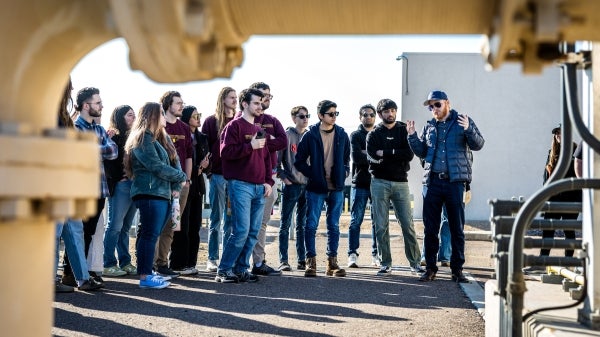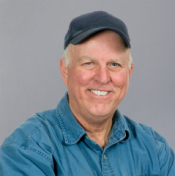ASU fire expert Stephen Pyne on learning to live alongside fire

Photo courtesy of iStock/Getty Images
Stephen Pyne is having a busy retirement. On top of caring for chickens, sheep and citrus on his urban farm in Queen Creek, Arizona, the Arizona State University professor emeritus is being called on by international media outlets to speak on what’s causing enormous urban fires and what we need to do to prevent them, especially in the wake of the recent tragedies in Los Angeles.
Pyne has written over 30 books on the history of human relationships with fire, and is known for coining the term “Pyrocene,” a substitute for the term “Anthropocene” that defines our current geological era through how humans have managed fire. In recent weeks, he has been featured in The Hollywood Reporter, the Los Angeles Times and NPR to elaborate on the problem of fire in modern cities. Here, he summarizes some of his main points.
Question: You study the history of humans’ relationship with fire. Can you tell me a little about how that relationship has changed over time?
Answer: Before the 20th century ... fire was common in people’s lives. But beginning in the late 18th century, aligning with the discovery of oxygen and the invention of new pyrotechnologies, fire got deconstructed into combustion and abstracted into energy. ... So fire now becomes something that runs machines, like steam engines — that's fire’s habitat, not the landscape. It lost both its natural and intellectual homes. Also, many agronomists, in addition to foresters, declared that fire is the divide between the primitive and the rational. Open burning was regarded as archaic, even anarchic. Alternatives to fire signified you were enlightened and modern. You have removed this messy, potentially dangerous and certainly primitive technology, and replaced it with a modern, rational one.
Fire has been around for 420 million years or so. Then humans tamed fire. We did all kinds of things with it, remade the world, but it was always within the context of living landscapes, which imposed boundaries; we co-evolved with it, so it always came with checks and balances.
With the burning of fossil fuels (or what I like to call lithic landscapes), all the old boundaries are gone. Day and night, winter and summer, wet and dry — none of that matters any longer. You can burn any time, and you remove fire from its habitat; it's kind of like a factory farm now. There's a lot of stuff to burn, but there's no place for its byproducts to go. I’ve come to think of this transition as geology’s version of "Jurassic Park": You've taken (fossil biomass) out of deep time and you've released it in the present, and then you're surprised that it belongs in a different world.
Q: So, do you see the recent Los Angeles fires as an example of the consequences of how humans misunderstand fire?
A: Yes. If you define fire as a physical problem, then your solutions are physical countermeasures, which is what we do. If you think of it as a biological problem, then you think of more biological responses, perhaps ecological engineering.
Think of fire like a virus. It’s not alive, but it depends on the living world and takes on many of life’s properties. Combustion even spreads as a kind of contagion. Now, if you think of fire in these terms, what kind of counter responses would you make? You wouldn't just go out there with bulldozers and airplanes dropping retardant.
And then you might think about how fire has been our companion for all our existence as a species. Why is it only over the last century we've lost control of it? Why is it that these big, megafires and urban conflagrations that we're seeing only happen in developed countries? Megafires turn out to be a pathology of development, synthesizing the world that modernity creates. Fire integrates whatever its setting is, and these are the kinds of fires you get if you build this kind of world.
Q: Do you think our understanding of fire should extend to the way we build our cities and plan our urban spaces?
A: Yes, of course. Cities used to burn as often as their surrounding countryside — buildings were made of the same materials and responded to the same weather and drought. And then a century or so ago, we more or less solved that with building codes, fire protection infrastructure, even creating an environment where insurance can operate, all of which essentially excluded these large urban fires to the point where we convinced ourselves that we don't have urban fires anymore, so we don't have to do all that fire-prevention hygiene. We created a vacuum that fire has reclaimed. It's as though we said, “Hey! We don't have polio anymore — you shouldn’t have to vaccinate.” So we didn’t, and polio returned.
It matters how we define the issue. Too often, what are urban conflagrations are being labeled wildland-urban fires. These are not wildland fires complicated by houses, but urban fires complicated by peculiar landscaping. Calling the wildfire as wildland doesn’t keep communities from burning; identifying it as urban tells us what we need to do to mitigate. Moreover, there are lots of small things we can do in and around our built environment (such as preventing fires started by power lines) to prevent megafires. The right mix of targeted interventions can add up to big reforms.
More Environment and sustainability

Single-use or reusable cups? New project seeks answers
Arizona State University researchers are collaborating with Yum! Brands on a joint research project to assess and better understand circular economy strategies that aim to replace single-use cups…

ASU Global Futures to lead Student Council Sustainability Officer Program
For over 11 years, through the Student Council Sustainability Officers Program, the city of Phoenix has engaged with students from their school districts to increase environmental stewardship.As…

From sludge to solutions: ASU students collaborate with city of Tempe on water treatment
Over the years, Arizona State University’s Project Cities has provided local communities and municipalities with expertise on sustainable solutions for parks, design research, solid waste, general…
